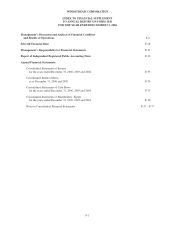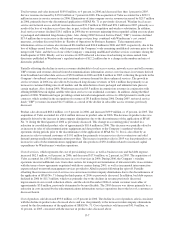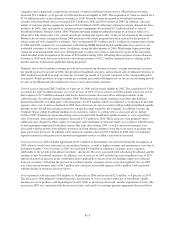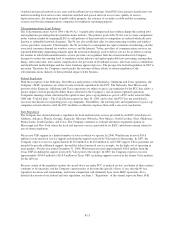Windstream 2006 Annual Report Download - page 111
Download and view the complete annual report
Please find page 111 of the 2006 Windstream annual report below. You can navigate through the pages in the report by either clicking on the pages listed below, or by using the keyword search tool below to find specific information within the annual report.
market rates for short-term investments and paid interest on amounts received from Alltel at a rate based on Alltel’s
weighted-average borrowing rate. Intercompany interest income increased $8.6 million and $38.5 million in 2006 and
2005, respectively. The increase in both periods is primarily due to an increase in the amount of funds remitted to
Alltel under the cash management program, combined with an increase in the advance interest rate. The Company has
canceled its participation in the cash management program following the spin-off from Alltel.
Interest Expense
Interest expense increased $190.5 million, or 997 percent, in 2006 and decreased $1.3 million, or 6 percent, in 2005. As
previously discussed, in conjunction with the spin-off from Alltel and merger with Valor, the Company borrowed
approximately $4.9 billion of long-term debt under a credit facility and through the issuance of senior notes, and
assumed $400.0 million principal value of additional senior notes from Valor. These borrowings, along with $181.0
million of debt issued by the Company’s wireline operating subsidiaries, resulted in approximately $5.5 billion of long-
term debt at December 31, 2006. The weighted-average interest rate paid on the long-term debt in periods following
the spin-off and merger was 7.8 percent.
Income Taxes
Income tax expense increased 3 percent in both 2006 and 2005, or $8.4 million and $8.5 million, respectively. The
increase in income tax expense in 2006 is due to the increase in income before income taxes, partially offset by a
settlement received from the Internal Revenue Service (“IRS”) during 2006 related to taxes paid during 1997 through
2003. The increase in income tax expense in 2005 was due primarily to the non-deductible expenses incurred related to
the spin-off, as previously discussed. The Company’s effective tax rate in 2006 was 38.3 percent, compared to 41.3
percent in 2005 and 40.2 percent in 2004. For 2007, the Company’s effective income tax rate is expected to range
between 39.0 and 41.0 percent. Changes in the relative profitability of our operation segments, as well as recent and
proposed changes to federal and state tax laws may cause the rate to change from historical rates. See Note 12,
“Income Taxes”, to the accompanying consolidated financial statements for further discussion of income tax expense
and deferred taxes.
Extraordinary Item
As previously discussed, during the third quarter of 2006, Windstream discontinued the application of SFAS No. 71.
Pursuant to the guidance in SFAS No. 101, “Discontinuation of the Application of FASB Statement No. 71,” the
impact of discontinuing the application of SFAS No. 71 was recognized as an extraordinary gain, net of taxes. See
Note 3, “Accounting Changes”, to the accompanying consolidated financial statements for further discussion of the
components of this gain.
Cumulative Effect of Accounting Change
During the fourth quarter of 2005, we adopted FASB Interpretation No. 47, “Accounting for Conditional Asset
Retirement Obligations” (“FIN 47”), which is an interpretation of SFAS No. 143, “Accounting for Asset Retirement
Obligations”. SFAS No. 143 addresses financial accounting and reporting for obligations associated with the retirement
of tangible long-lived assets and the associated asset retirement costs. This standard applies to legal obligations
associated with the retirement of long-lived assets that result from the acquisition, construction, development, or
normal use of the assets. SFAS No. 143 requires that a liability for an asset retirement obligation be recognized when
incurred and reasonably estimable, recorded at fair value and classified as a liability in the balance sheet. When the
liability is initially recorded, the entity capitalizes the cost and increases the carrying value of the related long-lived
asset. The liability is then accreted to its present value each period, and the capitalized cost is depreciated over the
estimated useful life of the related asset. At the settlement date, the entity will settle the obligation for its recorded
amount and recognize a gain or loss upon settlement. FIN 47 states that the accounting guidance in SFAS No. 143 is
applicable to asset retirement obligations that are conditional on the occurrence of a future event.
We evaluated the effects of FIN 47 on our operations and determined that, for certain buildings containing asbestos, we
are legally obligated to remediate the asbestos if we were to abandon, sell or otherwise dispose of the buildings. In
addition, we are legally obligated to properly dispose of our chemically-treated telephone poles at the time they are
removed from service. In accordance with federal and state regulations, depreciation expense for our ILEC operations
that followed the accounting prescribed by SFAS No. 71 have historically included an additional provision for cost of
removal, and accordingly, the adoption of FIN 47 had no impact on these operations. The cumulative effect of this
change resulted in a non-cash charge of $7.4 million, net of income tax benefit of $4.6 million, and was included in net
income for the year ended December 31, 2005. Upon discontinuance of the provisions of SFAS No. 71, as previously
discussed, the provisions for FIN 47 were also applied to chemically-treated telephone poles in the Company’s other
wireline operations. The impact of applying the provisions of FIN 47 is included in the non-cash extraordinary gain
previously discussed.
F-10
























